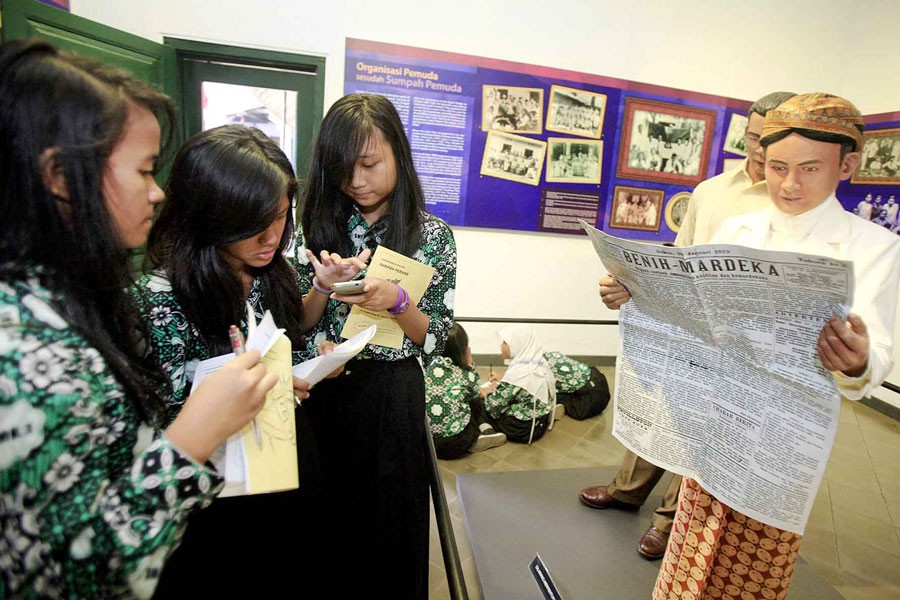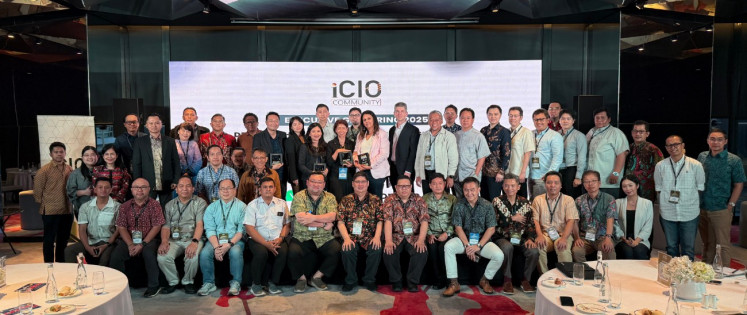Popular Reads
Top Results
Can't find what you're looking for?
View all search resultsPopular Reads
Top Results
Can't find what you're looking for?
View all search resultsJalur Rempah Nusantara: Origins of Indonesia language, literacy
Change text size
Gift Premium Articles
to Anyone
T
he Indonesian language and script has developed over hundreds of years, with the influence of various foreign traders. However, cultural factors hinder critical thinking and a proper literacy tradition.
The development of both the oral and written usage of our national language -- bahasa Indonesia, essentially a dialect variant of Malay -- has taken place over thousands of years, involving foreign influences thanks to human migration, trade and colonization.
The successful national adoption of the Indonesian language in particular owes to the history of the spice trade, involving Europeans who came to Indonesia in the 15th and 16th centuries to profit from the country's lucrative endemic spices.
University of Indonesia (UI) Cultural School linguistics department lecturer Mohammad Umar Muslim said Malay was brought by migrants from Thailand who arrived in Indonesia as early as the first century.
"The migrants familiarized the language to people living on the islands we know today as Kalimantan and Sumatra. In Sumatra, for instance, the ancient Malay language has evolved into the local Minangkabau language. From there, the Malay language in Indonesia continued to evolve," he said.
Although ancient Indonesians spoke Malay, the script they used for written communication varied based on influences from foreign traders who came as early as the fifth century, according to National Archaeology Research Center researcher Bambang Budi Utomo.
"Inscriptions found in the ancient Tarumanegara Kingdom in West Java, for instance, use the ancient Pallava script brought by Indian traders who came to Indonesia in the fifth century," he said.
During the eighth and ninth centuries, meanwhile, trends started to shift, with inscriptions starting to use a Javanese variant of Arabic script brought by Arabic traders who came to Indonesia.
"The Javanese variant of Arabic script eventually became what we know today as ancient Javanese script," Bambang explained.
Things, however, started to change during the Dutch occupation, when, in around the 20th century, van Obhuisen introduced Latin script to local elites, which we still use today for written communication.
During the time of the ancient kingdoms right up to the colonization period, written language was monopolized by the political elite, who learned the script from Indian traders so they could communicate with one another. The kingdoms' subjects, meanwhile, used only oral communication, according to Bambang.
He said this was also the reason behind the paucity of local sources relating to the history of the ancient Kingdom of Sriwijaya, which rose to power in the seventh century and declined around 500 years later.
"Most of the sources we have are from records written by the Arab and Chinese traders, who have a strong written communication tradition," Bambang explained.
Near the end of the Dutch education, however, the colonists started to introduce schools for poor Indonesians so more people could get access to literacy. During the nationalist movement period, nationalists campaigned for the Indonesian language -- derived from the Malay root -- to be used as the national language.
The adoption of our Malay dialect as a national language called bahasa Indonesia took place during the Second Youth Congress of nationalists in 1928.
"The campaign was successful not only because Malay had been used as a lingua franca for trading purposes across Indonesia for centuries but, curiously enough, also because the Malay ethnic group constitute only a small percentage -- less than 10 percent -- of Indonesia's whole population," Mohammad said.
According to Mohammad, ironically, if Indonesia had instead chosen the Javanese language -- spoken by an ethnic group that constitutes more than 50 percent of Indonesia's total population -- as its national language, it might have triggered social jealousy due to the higher visibility of the Javanese people.
"This is also the reason why the adoption of Hindi as a national language in India has not been as successful as Indonesian has been here, not only because Hindi is associated with a particular ethnic group, which is quite large there, but also because English is more popular among Indians," he explained.
The success of adopting our dialect of Malay as the national language, coupled with the adoption of the Latin alphabet, has resulted in an illiteracy rate of just 3.5 percent in 2015.
In a way, we should acknowledge the contributions of the Thai migrants, the Indian and Arab traders as well as the Dutch colony for influencing the national language we know today.
The sad fact is: although most Indonesians are now literate, this ability to read and write is not followed by proper reading habits and a strong literary tradition.
Last year, Central Connecticut State University in the United States placed Indonesia second to last in its ranking of 61 countries for their "literacy behavior characteristics," which include reading habits, book availability and years of schooling, among other things. It was very embarrassing. But, why?
"We don't have a tradition separating science and religion. Therefore, many people are afraid of being accused of blasphemy or tarnishing local traditions if they write or express something that runs contrary to local religious and cultural values," Mohammad explained.
He added that as long as intellectuals were afraid to express their ideas openly through their writings, a proper ecosystem for a literary tradition, which encouraged reading habits, would never flourish in Indonesia.
He took the US as a good example of how science and religion were separated, resulting in a strong literary tradition and considerable scientific advancements.
For example, when the administration of George W. Bush -- a conservative Christian -- faced a class-action suit by religious fundamentalists to teach the creationist version of science in schools, the lawsuit failed despite the Constitutional Court judge being a conservative himself.
Even Pakistan, a country torn by war, is able to separate religion and science.
"For instance, Pakistani physics Nobel prize winner Abdus Salam, despite being a devout Muslim, was able to make peace with the fact that his scientific findings ran contrary to his faith," Mohammad said.
Sebastian Partogi, The Jakarta Post, Depok, West Java











